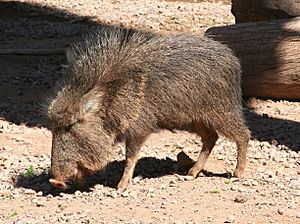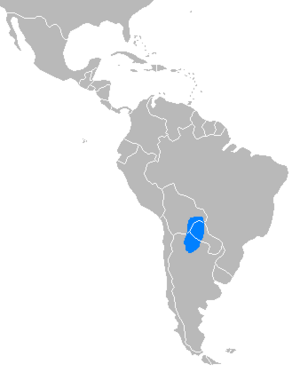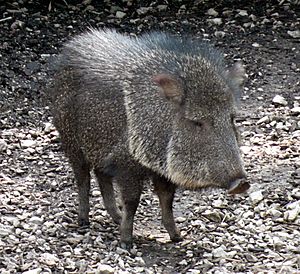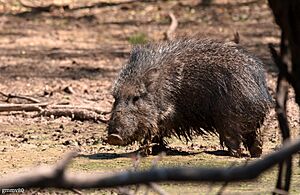Chacoan peccary facts for kids
Quick facts for kids Chacoan peccary |
|
|---|---|
 |
|
| Male at the Phoenix Zoo | |
 |
|
| Female at the San Diego Zoo | |
| Conservation status | |
| Scientific classification | |
| Genus: |
Catagonus
|
| Species: |
wagneri
|
 |
|
| Synonyms | |
|
Parachoerus wagneri Rusconi, 1930 |
|
The Chacoan peccary, also known as the tagua, is a type of wild pig. Its scientific name is Catagonus wagneri. It is the only living species in its group, Catagonus. These animals live in the Gran Chaco region of Paraguay, Bolivia, and Argentina. Sadly, there are only about 3,000 Chacoan peccaries left in the world.
What's really interesting about the Chacoan peccary is how it was discovered. Scientists first described it in 1930 using fossils. They thought it was an animal that had died out long ago. But in 1971, people found out that the Chacoan peccary was still alive! It was living in the Chaco region, in a part of Argentina called Salta. Local people already knew about this animal, calling it the tagua. But it took a while for scientists from other parts of the world to believe it existed.
Contents
What is a Chacoan Peccary?
The Chacoan peccary is special because it's the only living member of its group, Catagonus. But it's not the original animal that gave the group its name. That was an extinct species called Catagonus metropolitanus. When an animal thought to be extinct is found alive, it's called a Lazarus taxon. The Chacoan peccary is like the bush dog, another South American animal, in this way. Scientists officially described the living Chacoan peccary in 1972.
Some newer studies suggest that the Chacoan peccary might belong to a different group called Parachoerus. If this idea is accepted, then the Catagonus group would once again only include extinct animals.
Where Do Chacoan Peccaries Live?
Chacoan peccaries live in very hot and dry places. Their home, the Gran Chaco, covers about 140,000 square kilometers. This area has many low-growing succulent plants and thorny bushes. You might see a few large trees, but most of the plants are thorny scrub.
Chacoan peccaries have special features to help them live in this dusty, dry environment. They have well-developed sinuses (air-filled spaces in their skull) to handle the dry air. Their small feet also help them move easily through the spiny plants.
What Do Chacoan Peccaries Look Like?
The Chacoan peccary is the biggest of the three main types of peccaries. It looks a lot like a pig. It has a strong snout with tough, leathery skin. Its hair is usually brown or grayish and feels like bristles. A dark stripe runs down its back, and it has white fur on its shoulders.
Chacoan peccaries are different from other peccary species in a few ways:
- They have longer ears, snouts, and tails.
- They have white hairs around their mouth.
- They have a third toe on their back feet, while other peccaries only have two.
Their teeth are strong and help them eat tough plants. Their upper canine teeth point downwards. This is a special feature of peccaries. It might help them signal to each other to stay together in the thick bushes.
How Do Chacoan Peccaries Have Babies?
Chacoan peccary babies are usually born between September and December. However, babies can be born almost any time of the year. Births often happen when there is plenty of food and rain. On average, a mother will have about 2 or 3 babies.
Female peccaries might leave their group to give birth and then come back later. Newborn peccaries are very developed at birth. They can run just a few hours after they are born! Young peccaries look like the adults. Male and female peccaries look very similar.
How Do Chacoan Peccaries Behave?
Chacoan peccaries often live in groups of up to 20 animals. They are active during the day, especially in the morning when they travel most. These groups usually follow a 42-day travel pattern within their home area. This helps them keep an eye on their territory.
These social animals talk to each other using different sounds. They make grunts and chatter their teeth. Sometimes, individual peccaries might act aggressively, like charging or biting. But this species is generally not as aggressive as other peccaries.
When they feel threatened, a group of peccaries might form a defensive line. This makes it harder for predators or hunters to attack them. Chacoan peccaries also make a milky, strong-smelling liquid. They use this liquid to mark trees and bushes. They rub their backs against things to spread the scent from glands on their backs. They also like to bathe in mud or dust. They often go to special "stations" to poop.

What Do Chacoan Peccaries Eat?
The dry Gran Chaco region has very tough plants for the Chacoan peccary to eat. These peccaries mostly eat different kinds of cacti. For example, they eat Cleistocactus baumannii and Opuntia discolor. They use their strong snout to roll cacti on the ground, which helps rub off the spines. They might also pull off spines with their teeth and spit them out.
Their kidneys are special and can break down acids from the cacti. They also have two-chambered stomachs, which are great for digesting tough foods. Sometimes, they eat the roots of bromeliad plants, acacia pods, and fallen cactus flowers.
Chacoan peccaries also look for salt licks. These are places where they can get important minerals like calcium, magnesium, and chlorine. They find these salt licks on ant mounds or near human construction sites like roads.
Why Are Chacoan Peccaries Endangered?
The Chacoan peccary lives in a part of South America that used to be very isolated. This makes them very sensitive to human activities. When they are found in a new area, they often disappear quickly. The number of peccaries is going down because their habitat is being destroyed and broken into smaller pieces. Their home is quickly being turned into large ranches.
Hunting is still a problem for them. Also, an unknown disease has been affecting the peccary groups in recent years. To help save them, some Chacoan peccaries now live in zoos in North America and Europe. There are also nature preserves in Paraguay, but these are not always well protected.
See also
 In Spanish: Pecarí del Chaco para niños
In Spanish: Pecarí del Chaco para niños



